Regulation of the Thermoelectric Properties of Perovskite RECoO3 Ceramics via High-Entropy Engineering
Abstract
1. Introduction
2. Materials and Methods
3. Results and Discussion
3.1. XRD Analysis
3.2. Microstructure and Composition Analysis
3.3. Thermoelectric Properties
4. Conclusions
Author Contributions
Funding
Data Availability Statement
Acknowledgments
Conflicts of Interest
References
- Snyder, G.J.; Toberer, E.S. Complex thermoelectric materials. Nat. Mater. 2008, 7, 105–114. [Google Scholar] [CrossRef] [PubMed]
- Nie, G.; Li, W.; Guo, J.; Yamamoto, A.; Kimura, K.; Zhang, X.; Isaacs, E.B.; Dravid, V.; Wolverton, C.; Kanatzidis, M.G.; et al. High-Performance Thermoelectric Module through Isotype Bulk Heterojunction Engineering of Skutterudite Materials. Nano Energy 2019, 66, 104193. [Google Scholar] [CrossRef]
- Mukherjee, M.; Srivastava, A.; Singh, A.K. Recent advances in designing thermoelectric materials. J. Mater. Chem. C 2022, 10, 12524–12555. [Google Scholar] [CrossRef]
- Han, Z.; Li, J.W.; Jiang, F.; Xia, J.; Zhang, B.P.; Li, J.F.; Liu, W. Room-temperature thermoelectric materials: Challenges and a new paradigm. J. Mater. 2022, 8, 427–436. [Google Scholar] [CrossRef]
- Jia, S.; Qian, W.; Yu, P.; Li, K.; Li, M.; Lan, J.; Lin, Y.-H.; Yang, X. Ionic thermoelectric materials: Innovations and challenges. Mat. Today Phys. 2024, 42, 101375. [Google Scholar] [CrossRef]
- Ge, B.; Li, R.; Wang, G.; Zhu, M.; Zhou, C. Oxide semiconductors for thermoelectric: The challenges and future. J. Am. Chem. Soc. 2024, 107, 1985–1995. [Google Scholar] [CrossRef]
- Snyder, G.J.; Christensen, M.; Nishibori, E.; Caillat, T.; Iversen, B.B. Disordered zinc in Zn4Sb3 with phonon-glass and electron-crystal thermoelectric properties. Nat. Mater. 2004, 3, 458–463. [Google Scholar] [CrossRef]
- Yang, C.; Wu, H.; Song, H.; Wang, X.; Chen, S.; Xu, X.; Chen, L.; Zhao, Z.; Yu, L.; Liu, B. Ultralow thermal conductivity and enhanced thermoelectric properties in a textured (Ca0.35Sr0. 2Ba0. 15Na0.2Bi0.1)3Co4O9 high-entropy ceramic. J. Alloy. Compd. 2023, 940, 168802. [Google Scholar] [CrossRef]
- Hébert, S.; Flahaut, D.; Martin, C.; Lemonnier, S.; Noudem, J.; Goupil, C.; Maignan, A.; Hejtmanek, J. Thermoelectric properties of perovskites: Sign change of the Seebeck coefficient and high temperature properties. Prog. Solid State Chem. 2007, 35, 457–467. [Google Scholar] [CrossRef]
- Wu, T.; Gao, P. Development of perovskite-type materials for thermoelectric application. Materials 2018, 11, 999. [Google Scholar] [CrossRef]
- Fergus, J.W. Oxide materials for high temperature thermoelectric energy conversion. J. Eur. Ceram. Soc. 2012, 32, 525–540. [Google Scholar] [CrossRef]
- Bousnina, M.A.; Dujardin, R.; Perriere, L.; Giovannelli, F.; Guegan, G.; Delorme, F. Synthesis, sintering, and thermoelectric properties of the solid solution La1-xSrx CoO3±δ (0≤ x≤ 1). J. Adv. Ceram. 2018, 7, 160–168. [Google Scholar] [CrossRef]
- Wang, Y.; Sui, Y.; Ren, P.; Wang, L.; Wang, X.; Su, W.; Fan, H.J. Correlation between the Structural Distortions and Thermoelectric Characteristics in La1-xAxCoO3 (A=Ca and Sr). Inorg. Chem. 2010, 49, 3216–3223. [Google Scholar] [CrossRef] [PubMed]
- Robert, R.; Aguirre, M.H.; Bocher, L.; Trottmann, M.; Heiroth, S.; Lippert, T.; Doebeli, M.; Weidenkaff, A. Thermoelectric properties of LaCo1-xNixO3 polycrystalline samples and epitaxial thin films. Solid State Sci. 2008, 10, 502–507. [Google Scholar] [CrossRef]
- Jiamprasertboon, A.; Okamoto, Y.; Hiroi, Z.; Siritanon, T. Thermoelectric properties of Sr and Mg double-substituted LaCoO3 at room temperature. Ceram. Int. 2014, 40, 12729–12735. [Google Scholar] [CrossRef]
- Kumar, A.; Sivaprahsam, D.; Thakur, A.D. Improvement of thermoelectric properties of lanthanum cobaltate by Sr and Mn co-substitution. J. Alloy. Compd. 2018, 735, 1787–1791. [Google Scholar] [CrossRef]
- Lou, Z.; Zhang, P.; Zhu, J.; Gong, L.; Xu, J.; Chen, Q.; Reece, M.J.; Yan, H.; Gao, F. A novel high-entropy perovskite ceramics Sr0.9La0.1(Zr0.25Sn0.25Ti0.25Hf0.25)O3 with low thermal conductivity and high Seebeck coefficient. J. Eur. Ceram. Soc. 2022, 42, 3480–3488. [Google Scholar] [CrossRef]
- Messing, G.L.; Poterala, S.; Chang, Y.; Frueh, T.; Kupp, E.R.; Watson, B.H., III; Walton, R.L.; Brova, M.J.; Hofer, A.-K.; Bermejo, R.; et al. Texture-engineered ceramics-Property enhancements through crystallographic tailoring. J. Mater. Res. 2017, 32, 3219–3241. [Google Scholar] [CrossRef]
- Torres, M.; Costa, F.; Flahaut, D.; Touati, K.; Rasekh, S.; Ferreira, N.; Allouche, J.; Depriester, M.; Madre, M.; Kovalevsky, A.V.; et al. Significant enhancement of the thermoelectric performance in Ca3Co4O9 thermoelectric materials through combined strontium substitution and hot-pressing process. J. Eur. Ceram. Soc. 2019, 39, 1186–1192. [Google Scholar] [CrossRef]
- Noudem, J.G. A new process for lamellar texturing of thermoelectric Ca3Co4O9 oxides by spark plasma sintering. J. Eur. Ceram. Soc. 2009, 29, 2659–2663. [Google Scholar] [CrossRef]
- Miracle, D.B.; Senkov, O.N. A critical review of high entropy alloys and related concepts. Acta Mater. 2017, 122, 448. [Google Scholar] [CrossRef]
- George, E.P.; Raabe, D.; Ritchie, R.O. High-entropy alloys. Nat. Rev. Mater. 2019, 4, 515. [Google Scholar] [CrossRef]
- Oses, C.; Toher, C.; Curtarolo, S. High-entropy ceramics. Nat. Rev. Mater. 2020, 5, 295–309. [Google Scholar] [CrossRef]
- Liu, B.; Wu, J.; Cui, Y.; Zhu, Q.; Xiao, G.; Wu, S.; Cao, G.H.; Ren, Z. Structural evolution and superconductivity tuned by valence electron concentration in the Nb-Mo-Re-Ru-Rh high-entropy alloys. J. Mater. Sci. Technol. 2021, 85, 11. [Google Scholar] [CrossRef]
- Luo, Y.; Hao, S.; Cai, S.; Slade, T.J.; Luo, Z.Z.; Dravid, V.P.; Wolverton, C.; Yan, Q.; Kanatzidis, M.G. High Thermoelectric Performance in the New Cubic Semiconductor AgSnSbSe3 by High-Entropy Engineering. J. Am. Chem. Soc. 2020, 142, 15187. [Google Scholar] [CrossRef] [PubMed]
- Jiang, B.; Yu, Y.; Cui, J.; Liu, X.; Xie, L.; Liao, J.; Zhang, Q.; Huang, Y.; Ning, S.; Jia, B.; et al. High-Entropy-Stabilized Chalcogenides with High Thermoelectric Performance. Science 2021, 371, 830. [Google Scholar] [CrossRef]
- Zheng, Y.; Zou, M.; Zhang, W.; Yi, D.; Lan, J.; Nan, C.-W.; Lin, Y.-H. Electrical and Thermal Transport Behaviours of High-Entropy Perovskite Thermoelectric Oxides. J. Adv. Ceram. 2021, 10, 377. [Google Scholar] [CrossRef]
- Zhang, M.; Cai, J.; Gao, F.; Zhang, Z.; Li, M.; Chen, Z.; Wang, Y.; Hu, D.; Tan, X.; Liu, G.; et al. Improved Thermoelectric Performance of P-Type PbTe by Entropy Engineering and Temperature-Dependent Precipitates. ACS Appl. Mater. Interfaces 2024, 16, 907. [Google Scholar] [CrossRef]
- Gao, H.; Zhao, K.; Wuliji, H.; Zhu, M.; Xu, B.; Lin, H.; Fei, L.; Zhang, H.; Zhou, Z.; Lei, J.; et al. Adaptable Sublattice Stabilized High-Entropy Materials with Superior Thermoelectric Performance. Energy Environ. Sci. 2023, 16, 6046. [Google Scholar] [CrossRef]
- Xu, X.; Yang, W.Z.; Song, H.Y.; Wang, J.S.; Yu, L.; Ren, Z.; Liu, B. Structural sequence and superconductivity in high-entropy Mo-W-Re-Ru-Pd alloys. Scr. Mater. 2024, 243, 115986. [Google Scholar] [CrossRef]
- Liu, R.; Chen, H.; Zhao, K.; Qin, Y.; Jiang, B.; Zhang, T.; Sha, G.; Shi, X.; Uher, C.; Zhang, W.; et al. Entropy as a Gene-Like Performance Indicator Promoting Thermoelectric Materials. Adv. Mater. 2017, 29, 1702712. [Google Scholar] [CrossRef] [PubMed]
- Liu, B.; Yang, W.; Xiao, G.; Zhu, Q.; Song, S.; Cao, G.H.; Ren, Z. High-entropy silicide superconductors with W5Si3-type structure. Phys. Rev. Mater. 2023, 7, 014805. [Google Scholar]
- Rahaman, M.D.; Mia, M.D.; Khan, M.N.I.; Hossain, A.A. Study the effect of sintering temperature on structural, microstructural and electromagnetic properties of 10% Ca-doped Mn0.6Zn0.4Fe2O4. J. Magn. Magn. Mater. 2016, 404, 238–249. [Google Scholar] [CrossRef]
- Kharton, V.V.; Tsipis, E.V.; Yaremchenko, A.A.; Marozau, I.P.; Viskup, A.P.; Frade, J.R.; Naumovich, E.N. Oxygen permeability, electronic conductivity and stability of La0.3Sr0.7CoO3-based perovskites. Mat. Sci. Eng. B 2006, 134, 80–88. [Google Scholar] [CrossRef]
- Ma, Z.; Xu, T.; Li, W.; Cheng, Y.; Li, J.; Zhang, D.; Jiang, Q.; Luo, Y.; Yang, J. High entropy semiconductor AgMnGeSbTe4 with desirable thermoelectric performance. Adv. Funct. Mater. 2021, 31, 2103197. [Google Scholar] [CrossRef]
- Terasaki, I.; Sasago, Y.; Uchinokura, K. Large thermoelectric power in NaCo2O4 single crystals. Phys. Rev. B 1997, 56, R12685. [Google Scholar] [CrossRef]
- Liu, Y.; Zhang, L.; Shirsath, S.E.; Zheng, J.; Liu, Y.; Ulrich, C.; Li, S. Manipulation of charge carrier concentration and phonon scattering via spin-entropy and size effects: Investigation of thermoelectric transport properties in La-doped Ca3Co4O9. J. Alloy. Compd. 2019, 801, 60–69. [Google Scholar] [CrossRef]
- Kumar, A.; Dragoe, D.; Berardan, D.; Dragoe, N. Thermoelectric properties of high-entropy rare-earth cobaltates. J. Mater. 2023, 9, 191–196. [Google Scholar] [CrossRef]
- Kotiuga, M.; Zhang, Z.; Li, J.; Rodolakis, F.; Zhou, H.; Sutarto, R.; He, F.; Wang, Q.; Sun, Y.; Wang, Y.; et al. Carrier localization in perovskite nickelates from oxygen vacancies. Proc. Natl. Acad. Sci. USA 2019, 116, 21992–21997. [Google Scholar] [CrossRef]
- Sparks, T.D.; Gurlo, A.; Gaultois, M.W.; Clarke, D.R. Revised model for thermopower and site inversion in Co3O4 spinel. Phys. Rev. B 2018, 98, 024108. [Google Scholar] [CrossRef]
- Alroy, J. Cope’s rule and the dynamics of body mass evolution in North American fossil mammals. Science 1998, 280, 731–734. [Google Scholar] [CrossRef] [PubMed]
- Zhang, X.; Li, X.M.; Chen, T.L.; Chen, L.D. Thermoelectric and transport properties of La0.95Sr0.05CoO3. J. Cryst. Growth 2006, 286, 1–5. [Google Scholar] [CrossRef]
- Androulakis, J.; Migiakis, P.; Giapintzakis, J. La0.95Sr0.05CoO3: An efficient room-temperature thermoelectric oxide. Appl. Phys. Lett. 2004, 84, 1099–1101. [Google Scholar] [CrossRef]
- Hu, Y.D.; Li, Y.; Wu, H.R.; Tang, Y.Y.; Fan, K.; Liu, B.; Yu, L. Laser-induced transverse voltage effect in c-axis inclined CuCr0.98Mg0.02O2 thin films with dominant phonon thermal conductivity. J. Appl. Phys. 2021, 130, 143104. [Google Scholar] [CrossRef]
- Liu, X.; Zhang, P.; Huang, M.; Han, Y.; Xu, N.; Li, Y.; Zhang, Z.; Pan, W.; Wan, C. Effect of lattice distortion in high-entropy RE2Si2O7 and RE2SiO5 (RE= Ho, Er, Y, Yb, and Sc) on their thermal conductivity: Experimental and molecular dynamic simulation study. J. Eur. Ceram. Soc. 2023, 43, 6407–6415. [Google Scholar] [CrossRef]
- Körmann, F.; Ikeda, Y.; Grabowski, B.; Sluiter, M.H. Phonon broadening in high entropy alloys. npj Comput. Mater. 2017, 3, 36. [Google Scholar] [CrossRef]
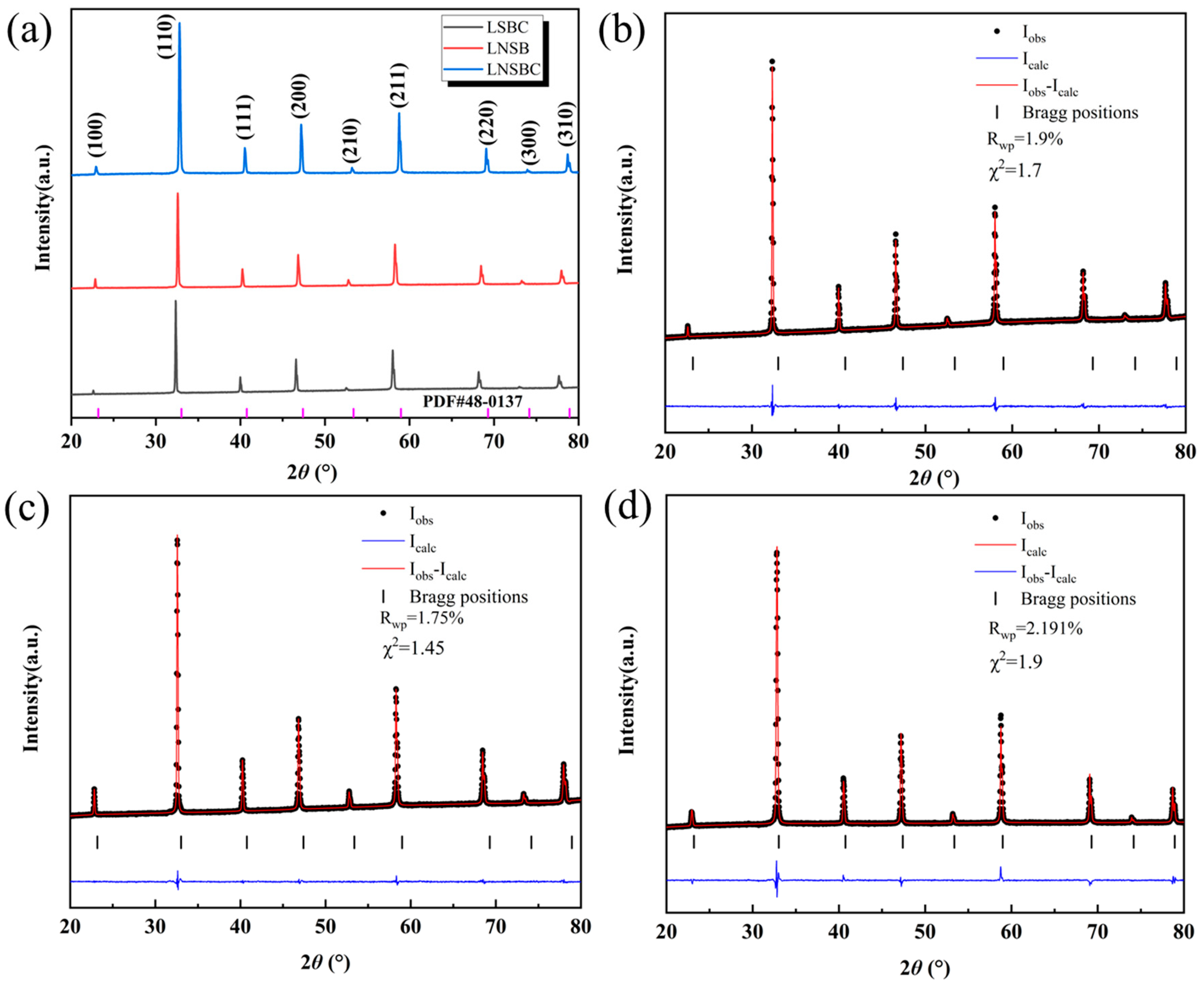
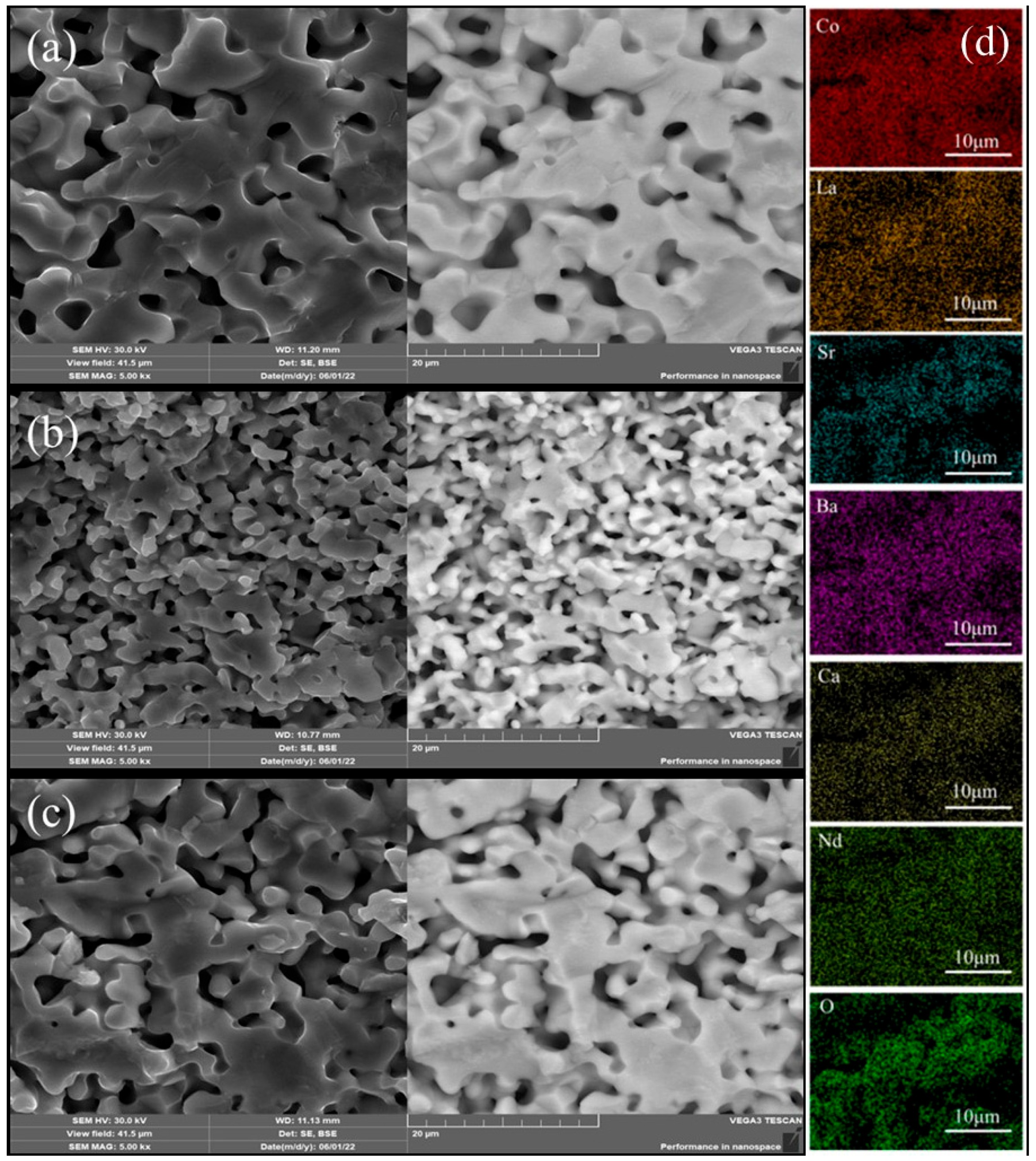
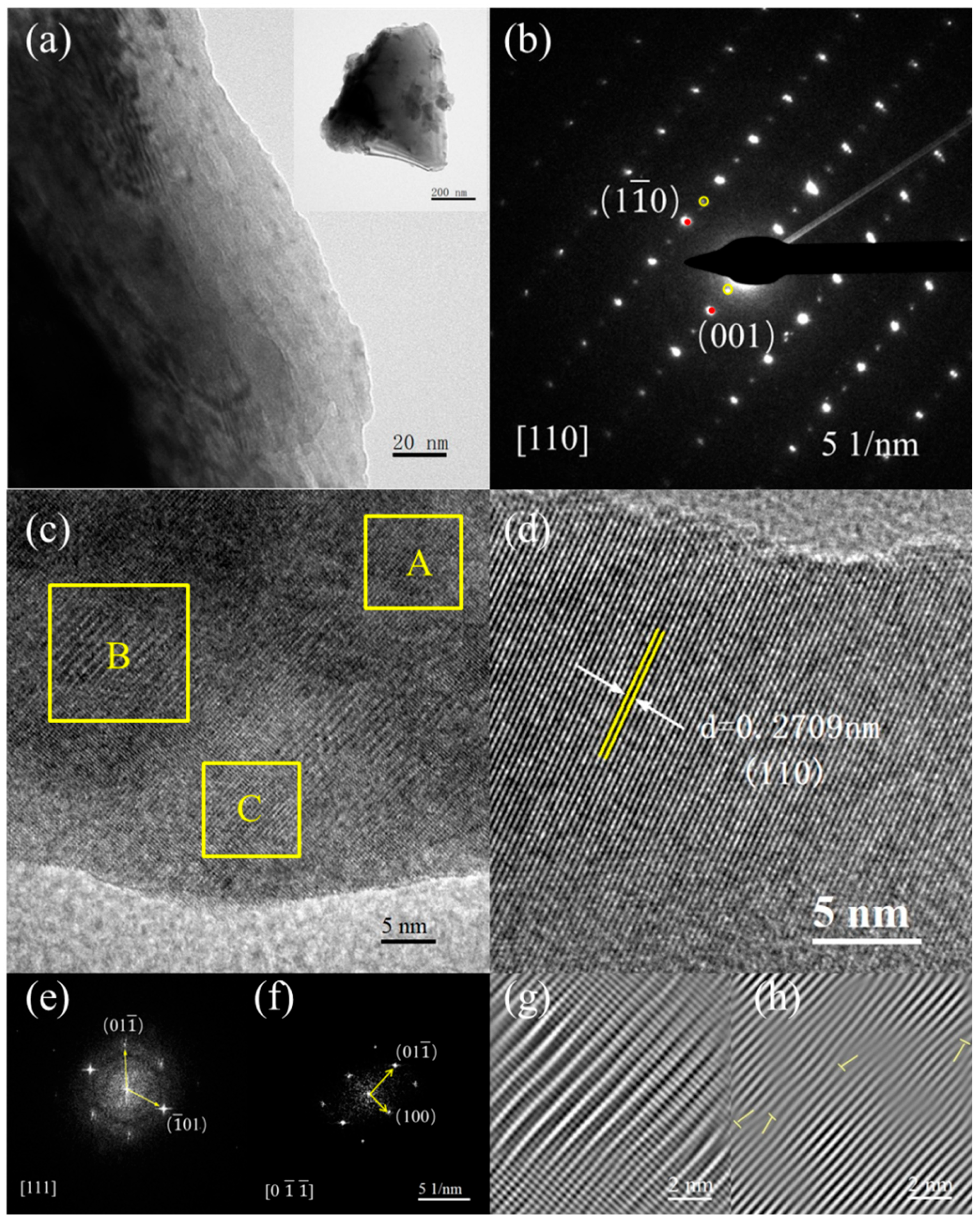
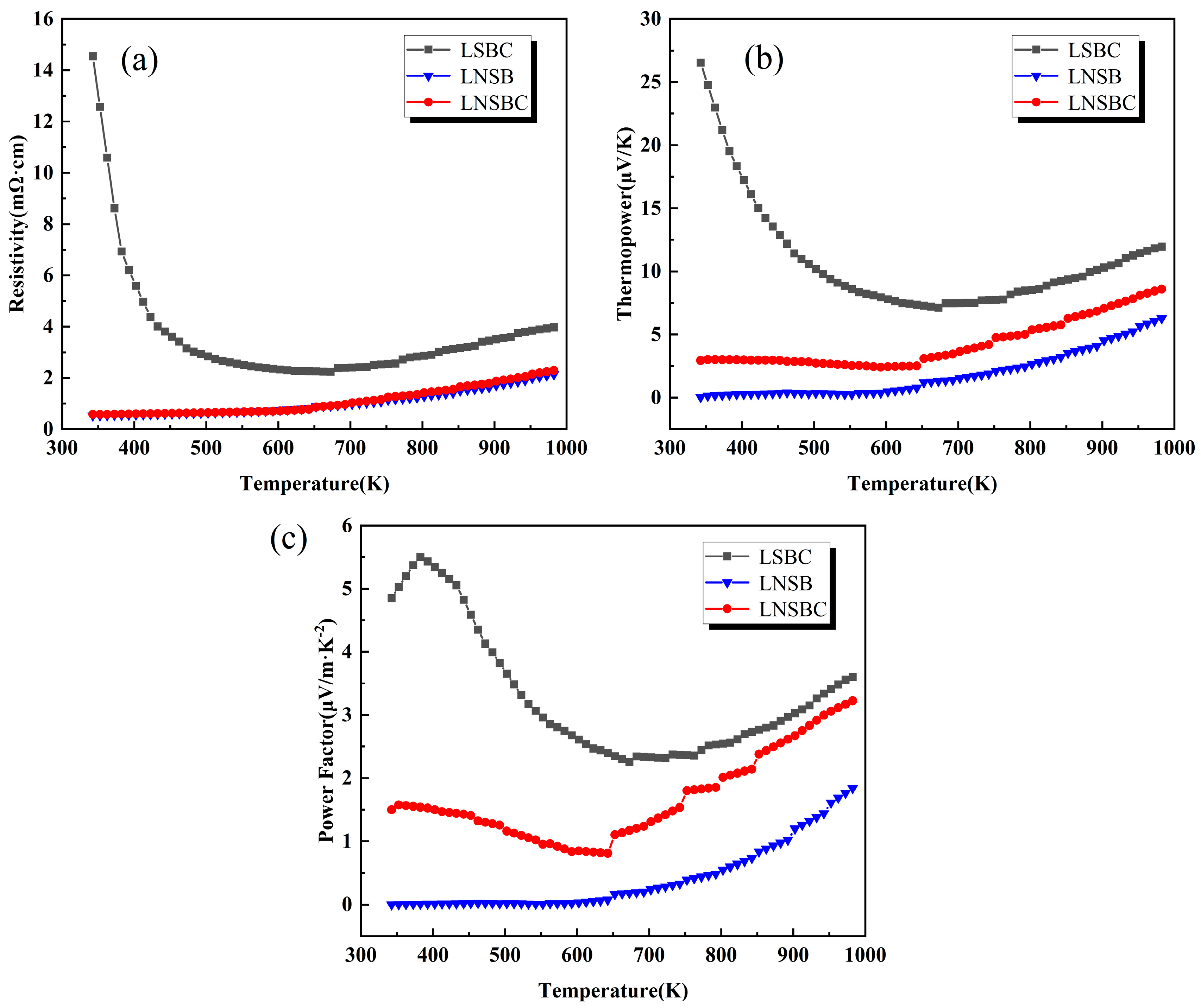

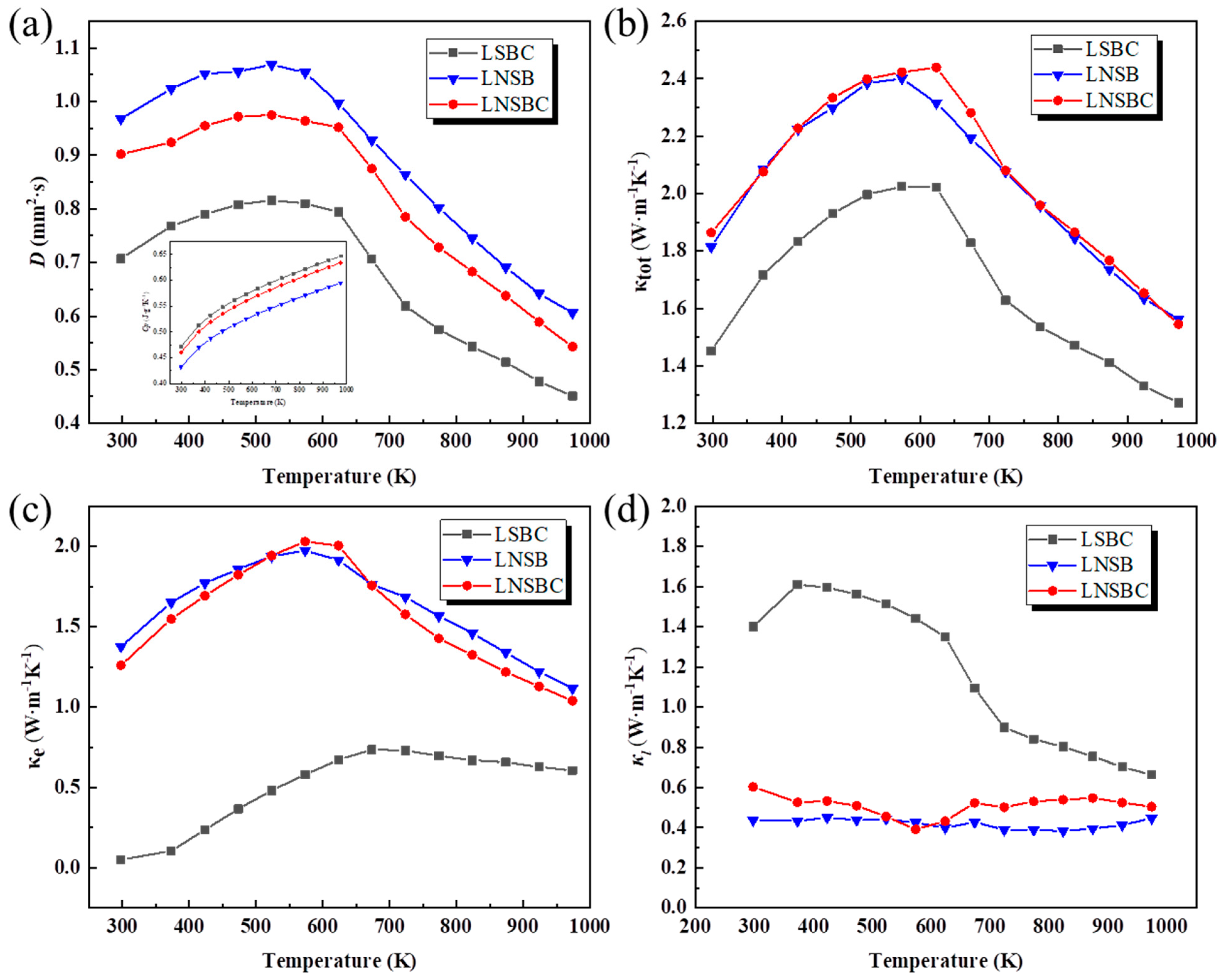
| Parameter | LSBC | LNSB | LNSBC |
|---|---|---|---|
| a (Å) | 3.8795(4) | 3.8596(2) | 3.8320(5) |
| α, β, γ (°) | 90 | 90 | 90 |
| Rwp (%) | 1.9 | 1.75 | 2.19 |
| χ2 | 1.7 | 1.45 | 1.9 |
| VRE | 2.25 | 2.5 | 2.4 |
| ρD (g·cm3) | 4.36 | 4.34 | 4.49 |
| n (1020 cm−3) | 1.06 | 6.70 | 3.57 |
| μH (cm2·V−1·s−1) | 45.0 | 16.3 | 28.8 |
| RH (cm3·C−1) | 5.9 × 10−2 | 9.32 × 10−3 | 1.7 × 10−2 |
| ρT = 300 K (mΩ·cm) | 14.5 | 0.53 | 0.58 |
| Smax (μV·K−1) | 27 | 6.3 | 8.7 |
| PFmax (μW·m−1·K−2) | 5.5 | 1.8 | 3.2 |
| κtot,min (W·m−1·K−1) | 1.27 | 1.56 | 1.54 |
Disclaimer/Publisher’s Note: The statements, opinions and data contained in all publications are solely those of the individual author(s) and contributor(s) and not of MDPI and/or the editor(s). MDPI and/or the editor(s) disclaim responsibility for any injury to people or property resulting from any ideas, methods, instructions or products referred to in the content. |
© 2025 by the authors. Licensee MDPI, Basel, Switzerland. This article is an open access article distributed under the terms and conditions of the Creative Commons Attribution (CC BY) license (https://creativecommons.org/licenses/by/4.0/).
Share and Cite
Zhang, K.; Yang, C.; Ao, X.; Zhao, Y.; Tan, W.; Wu, J.; Liu, B.; Dong, K.; Chen, L.; Yu, L. Regulation of the Thermoelectric Properties of Perovskite RECoO3 Ceramics via High-Entropy Engineering. Crystals 2025, 15, 285. https://doi.org/10.3390/cryst15030285
Zhang K, Yang C, Ao X, Zhao Y, Tan W, Wu J, Liu B, Dong K, Chen L, Yu L. Regulation of the Thermoelectric Properties of Perovskite RECoO3 Ceramics via High-Entropy Engineering. Crystals. 2025; 15(3):285. https://doi.org/10.3390/cryst15030285
Chicago/Turabian StyleZhang, Kezhen, Chengchao Yang, Xianpeng Ao, Yulong Zhao, Weihao Tan, Jinglong Wu, Bin Liu, Kun Dong, Liangwei Chen, and Lan Yu. 2025. "Regulation of the Thermoelectric Properties of Perovskite RECoO3 Ceramics via High-Entropy Engineering" Crystals 15, no. 3: 285. https://doi.org/10.3390/cryst15030285
APA StyleZhang, K., Yang, C., Ao, X., Zhao, Y., Tan, W., Wu, J., Liu, B., Dong, K., Chen, L., & Yu, L. (2025). Regulation of the Thermoelectric Properties of Perovskite RECoO3 Ceramics via High-Entropy Engineering. Crystals, 15(3), 285. https://doi.org/10.3390/cryst15030285






